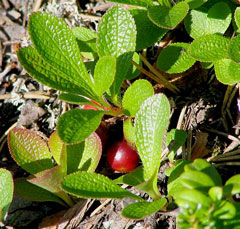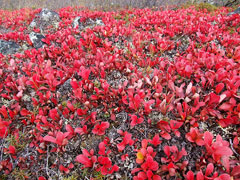 |
|
http://commons.wikimedia.org/wiki/File:Alpine_bearberry_in_Varrio_Nature_Reserve,_Finland.jpg |
 |
| http://flickr.com/photos/baggis/2968794136 |
Translate this page:
Summary
Physical Characteristics

 Arctostaphylos alpina is a deciduous Shrub growing to 0.1 m (0ft 4in) by 0.1 m (0ft 4in).
Arctostaphylos alpina is a deciduous Shrub growing to 0.1 m (0ft 4in) by 0.1 m (0ft 4in).
See above for USDA hardiness. It is hardy to UK zone 1 and is not frost tender. It is in flower from April to June. The species is hermaphrodite (has both male and female organs) and is pollinated by Bees. The plant is self-fertile.
Suitable for: light (sandy) and medium (loamy) soils and prefers well-drained soil. Suitable pH: mildly acid soils and can grow in very acid soils.
It can grow in semi-shade (light woodland) or no shade. It prefers moist soil.
UK Hardiness Map
US Hardiness Map
Synonyms
Arbutus alpina. Arctous alpina. (L.)Niedenzu.
Plant Habitats
Woodland Garden Sunny Edge; Cultivated Beds;
Edible Uses
Edible Parts: Fruit
Edible Uses:
Fruit - raw or cooked[2, 62, 105]. Very juicy but slightly bitter[101]. Another report says that they are juicy but insipid[257]. The flavour is much improved by cooking[257]. Not as nice as many other wild fruits, but nor are they unpleasant[2]. The fruit is about 6 - 9mm in diameter[200, 266], it is not usually produced very freely[257].
References More on Edible Uses
Medicinal Uses
Plants For A Future can not take any responsibility for any adverse effects from the use of plants. Always seek advice from a professional before using a plant medicinally.
Antirheumatic Blood purifier Narcotic
An infusion of the pounded plant has been used as an external wash in the treatment of rheumatism and general illnesses[257]. A decoction of the bark is used in the treatment of internal blood diseases[257]. The leaves are narcotic and have been smoked to cause intoxication[257].
References More on Medicinal Uses
The Bookshop: Edible Plant Books
Our Latest books on Perennial Plants For Food Forests and Permaculture Gardens in paperback or digital formats.

Edible Tropical Plants
Food Forest Plants for Hotter Conditions: 250+ Plants For Tropical Food Forests & Permaculture Gardens.
More

Edible Temperate Plants
Plants for Your Food Forest: 500 Plants for Temperate Food Forests & Permaculture Gardens.
More

More Books
PFAF have eight books available in paperback and digital formats. Browse the shop for more information.
Shop Now
Other Uses
References More on Other Uses
Cultivation details
Requires a deep moist well-drained light or medium lime-free loam in sun or semi-shade[182, 200]. Prefers a cool damp position[11]. Plants resent root disturbance and should be placed in their final positions as soon as possible[134]. Grows well in a rock garden[11]. This plant is placed in a separate genus, as Arctuous alpinus, by some botanists due to its deciduous habit[11, 200].
References Carbon Farming Information and Carbon Sequestration Information
Temperature Converter
Type a value in the Celsius field to convert the value to Fahrenheit:
Fahrenheit:
The PFAF Bookshop
Plants For A Future have a number of books available in paperback and digital form. Book titles include Edible Plants, Edible Perennials, Edible Trees,Edible Shrubs, Woodland Gardening, and Temperate Food Forest Plants. Our new book is Food Forest Plants For Hotter Conditions (Tropical and Sub-Tropical).
Shop Now
Plant Propagation
Seed - best sown in a shady position in a greenhouse as soon as it is ripe[78]. Pre-soak dried seed and sow as early in the year as possible[134]. The seed usually germinates in 2 - 3 months at 15°c[134]. When large enough to handle, prick the seedlings out into individual pots and grow them on in greenhouse or cold frame for at least their first winter. Plant out in late spring or early summer. Cuttings of side shoots, 5 - 8cm with a heel, August to December in a frame. Takes one year[78]. Division in early spring. Take care because the plant resents root disturbance[200]. Pot the divisions up and keep them in a lightly shaded position in a cold frame or greenhouse until they are growing away actively. Layering in spring[200].
Other Names
If available other names are mentioned here
Native Range
TEMPERATE ASIA: Russian Federation-Eastern Siberia (Eastern Siberia), Russian Federation (Altay), Kazakhstan, Kyrgyzstan, Mongolia, Russian Federation-Far East (Far East) NORTHERN AMERICA: Greenland, Canada (Québec, Ontario, Newfoundland and Labrador, Saskatchewan, Alberta, Manitoba, British Columbia), United States (Alaska, Maine, New Hampshire) EUROPE: Finland, United Kingdom, Norway, Austria, Switzerland, Germany, Russian Federation (European part), Belarus, Ukraine, Albania, Croatia, Italy, Slovenia, Spain, France
Weed Potential
Right plant wrong place. We are currently updating this section.
Please note that a plant may be invasive in one area but may not in your area so it's worth checking.
Conservation Status
IUCN Red List of Threatened Plants Status :

| Related Plants
|
| Latin Name | Common Name | Habit | Height | Hardiness | Growth | Soil | Shade | Moisture | Edible | Medicinal | Other |
| Arctostaphylos columbiana | Hairy Manzanita | Shrub | 1.5 |
6-9
| | LM | SN | M | 2 | 1 | 2 |
| Arctostaphylos glauca | Bigberry Manzanita | Shrub | 4.0 |
7-10
| | LM | SN | DM | 2 | 2 | 3 |
| Arctostaphylos manzanita | Manzanita, Whiteleaf manzanita, Konocti manzanita, Contra Costa manzanita, Roof's manzanita, Wieslan | Shrub | 2.0 |
7-10
| M | LM | SN | DM | 3 | 1 | 3 |
| Arctostaphylos nevadensis | Pine-Mat Manzanita | Shrub | 0.1 |
5-9
| M | LM | SN | M | 2 | 1 | 3 |
| Arctostaphylos parryana | Parry Manzanita | Shrub | 1.8 |
-
| | LM | SN | DM | 1 | 0 | 1 |
| Arctostaphylos patula | Greenleaf Manzanita | Shrub | 2.0 |
5-9
| | LM | SN | M | 3 | 1 | 1 |
| Arctostaphylos pringlei | Stickleaf Manzanita | Shrub | 2.0 |
7-9
| M | LM | N | DM | 3 | 0 | 1 |
| Arctostaphylos pungens | Grayleaf manzanita, Pointleaf Manzanita | Shrub | 2.0 |
7-10
| | LM | SN | DM | 3 | 1 | 2 |
| Arctostaphylos stanfordiana | Stanford's manzanita, Rincon manzanita | Shrub | 1.5 |
5-9
| | LM | SN | DM | 3 | 0 | 1 |
| Arctostaphylos tomentosa | Downy Manzanita, Woollyleaf manzanita, Brittleleaf manzanita, Dacite manzanita, Rosy manzanita, San | Shrub | 1.5 |
7-10
| | LM | SN | M | 3 | 3 | 3 |
| Arctostaphylos uva-ursi | Bearberry, Kinnikinnick | Shrub | 0.1 |
2-8
| M | LM | FSN | M | 3 | 4 | 4 |
| Vaccinium arctostaphylos | Caucasian Whortleberry | Shrub | 3.0 |
5-9
| | LM | SN | M | 3 | 0 | 0 |
|
Growth: S = slow M = medium F = fast. Soil: L = light (sandy) M = medium H = heavy (clay). pH: A = acid N = neutral B = basic (alkaline). Shade: F = full shade S = semi-shade N = no shade. Moisture: D = dry M = Moist We = wet Wa = water.
Now available:
Food Forest Plants for Mediterranean Conditions
350+ Perennial Plants For Mediterranean and Drier Food Forests and Permaculture Gardens.
[Paperback and eBook]
This is the third in Plants For A Future's series of plant guides for food forests tailored to
specific climate zones. Following volumes on temperate and tropical ecosystems, this book focuses
on species suited to Mediterranean conditions—regions with hot, dry summers and cool, wet winters,
often facing the added challenge of climate change.
Read More
Expert comment
Author
(L.)Spreng.
Botanical References
1117200
Links / References
For a list of references used on this page please go here
Readers comment
© 2010, Plants For A Future. Plants For A Future is a charitable company limited by guarantee, registered in England and Wales. Charity No. 1057719, Company No. 3204567.